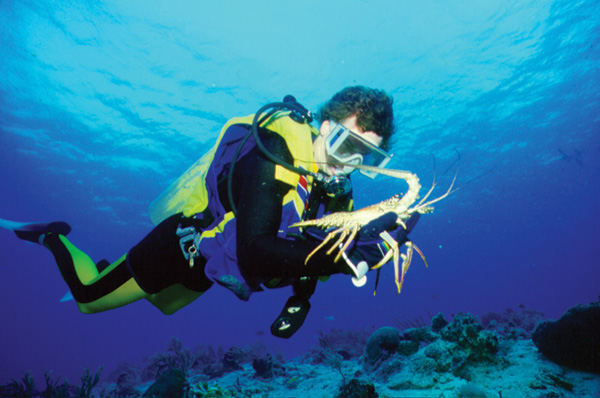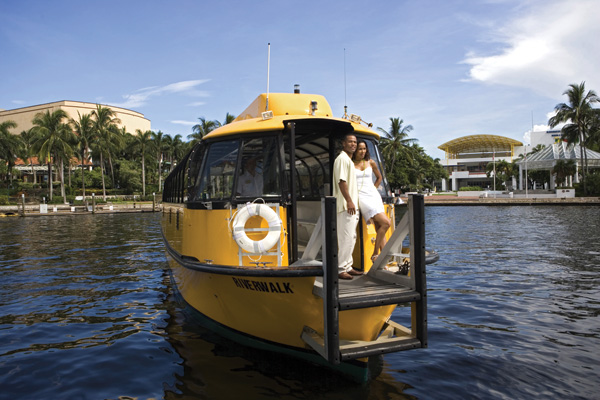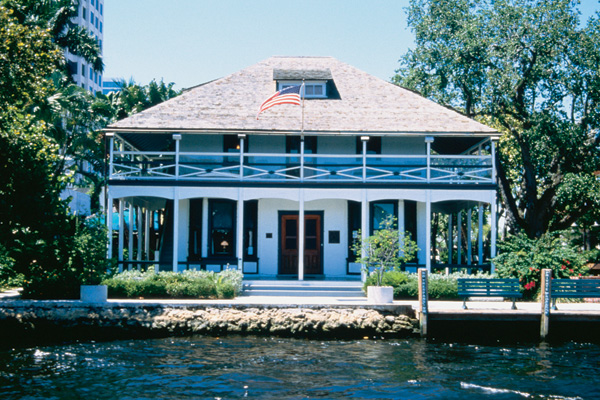FT. LAUDERDALE, FLA. - A lace curtain blows out of an upper floor window at a green-trimmed house on Riverwalk Promenade.
The event intrigues my guide Jennifer.
“Hmm, that’s interesting,” says the young woman, whose surprise look peaks my curiosity.
“That window shouldn’t be open — unless .....”
“Unless what?” I wonder.
“Unless Louise opened it.”
“Louise? Who’s Louise?”
“Louise is the ghost who occupies that house,” says Jennifer matter-of-factly. “She’s just one of the many ghosts living in this part of town.”
I’m dying to know more but at that very moment I’m distracted by a man wearing a black hat and cloak who passes with a large group of people following in his footsteps.
“Who is .....”
Before I can finish the question, I’m interrupted again, this time by two black cats who startle me as they scurry through the house’s neatly-kept garden.
Exasperated, I wait for Jennifer to explain the goings on.
“The house is the old King-Cromartie House, once owned by Edwin T. King, a very important man back at the turn of the century here in Fort Lauderdale. He built the house for his daughter, Louise. Unfortunately she died. But her spirit never left the house.
“He (the man in the black hat and cloak) is a ghost tour guide. Some of the ghosts you’ll find here are those of early settlers who were killed during a Seminole Indian uprising.”


Left: Ft. Lauderdale is one of the best diving spots in North America. Right: The water taxi drivers in Ft. Lauderdale are a great source of information.
Gulp!
“The ghost tours have become a very popular attraction here on Riverwalk,” says Jennifer of the revitalized 22-block downtown district that borders the slow flowing New River.
Riverwalk certainly has an effect on visitors, but not because of its ghosts. The renaissance walkway meanders through the historic part of Ft. Lauderdale and introduces visitors to lovely green spaces and some heritage buildings that date back to the city’s earliest days.
It runs from chic Las Olas Blvd. — home to upscale shops, hotels and restaurants — and west to the beautiful Broward Centre for the Performing Arts. Sandwiched in between is an entertainment district that has become the place to be seen after dark. Trendy restaurants and clubs attract the young and young at heart, and families are lured to the area by some theme park attractions located on the river’s edge. On weekends, the sound of jazz fills the air as groups perform for visitors in brightly-coloured band shells.
Just off Riverwalk we come upon the handsome New River Inn, the city’s first hotel whose antebellum design reminds people of a gentler time in the south, now houses the city’s Museum of History. The nearby Philemon Bryan House, home to the Ft. Lauderdale Historical Society, is another place that keeps visitors intrigued.
To get the “inside” story on Ft. Lauderdale, though, you might have to jump aboard one of the city’s famed water taxis — the captains are renowned for their expertise about the people who own the magnificent homes and boats on the river and intercoastal waterways, says Jennifer.
“The water taxi drivers seem to know everyone who lives in those mansions,” says Jennifer, who warns: “sometimes the captains embellish the facts a bit.”
Why let facts get in the way of a good story, appears to be their motto.
The sleek powerboats and yachts tied up along the New River are some of the biggest we’ve ever seen. Jennifer tells me the docks can cost as much as the boats.
“Most of those boats cost well over $1 million (U.S.),” says Jennifer, who points to the fact that Ft. Lauderdale is the boating capital of North America — maybe the world.
“At our annual boat show, over $2.5 billion (U.S.) of inventory is sold,” she says. “There are over 42,000 registered boaters — some people claim there are more boats than cars here.”
The New River, the deepest in Florida, is where the boaters like to congregate. The river has been the lifeline for people living here for over 5,000 years. The prehistoric peoples of South Florida, known as the “Glades Culture” relied heavily on this river that gently flows to the sea.

Above: The Stranahan House was built by Frank Stranahan, the man who founded Ft. Lauderdale.
You can learn a lot about Ft. Lauderdale by simply walking along the river, the only one in Florida that has a tunnel running under it.
Ft. Lauderdale is the culture capital of Florida, with some of the biggest and best museums and performing arts facilities in the United States.
One of the most impressive buildings one sees on a Riverwalk tour is the Performing Arts Centre, which features an excellent series of Broadway shows each year. The series makes the many ex-New Yorkers living in Ft. Lauderdale feel right at home. And there’s lots of them. In fact, some people refer to Ft. Lauderdale as a “borough” of the Big Apple.
From Las Olas Blvd., you can also visit some of the city’s other historic haunts, like the Stranahan House, the one-time home of Frank Stranahan, the man who founded Ft. Lauderdale.
The city’s downtown core is compact and easy to walk. There’s plenty of great dining spots to enjoy and the Riverside Hotel, built by the Wells family of Wells Fargo fame back in 1934, invites people to pull up a chair and relax on its delightful patio.
The city also has a number of festivals each year, including a Canadafest in late January, which features Canadian and American entertainers performing on the beach and Riverwalk. Canadians make up the largest segment of international visitors to Ft. Lauderdale, with over 600,000 stopping here each year.
Shopping continues to be big draw — the city’s famous Sawgrass Mills Mall attracts 24 million visitors annually (only a few million less than Orlando’s Disney World).
Ft. Lauderdale is such a special place even the ghosts don’t want to leave.